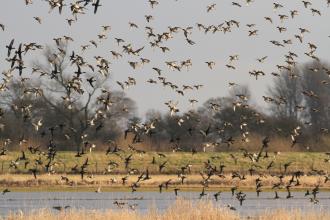Working towards a thriving river catchment
The Yorkshire Derwent Catchment Partnership (YDCP) is one of over 100 catchment partnerships who follow the ‘Catchment Based Approach’, or CaBA for short. This initiative was launched by Defra in 2012 to encourage and facilitate collaborative working at a river catchment scale to help to protect our water environment.
Our CaBA partnership has been fully established since 2016. Our partnership is made up of environmental NGOs, local authorities, government agencies, landowner representatives and farmer representative bodies and is hosted by us at Yorkshire Wildlife Trust. We work together to deliver a wide range of projects across the catchment to meet our vision and our key aims.
Our vision is for a thriving river with a catchment abundant in wildlife, providing a better quality environment for people to live, work and visit.
Our key aims
- Ensure a resilient catchment through community engagement and promoting integrated, sustainable land management which benefits the rural economy
- Improve water level management, reducing flood risk and preserving water resources
- Secure better soil conservation and water quality
- Create extensive habitat connectivity and species resilience
- Ensure good partnership governance and develop a robust evidence base

Follow the Derwent from moor to meadow
Go on a journey with the River Derwent from a high moorland stream in the North York Moors National Park, weaving through wooded valleys and flowing into a network of internationally-renowned floodplain meadows.
Discover more about the wildlife of the Derwent and why certain areas are specially protected.
How we're restoring and improving the Derwent Catchment
Restoring and creating habitat
While the Derwent Catchment contains areas rich in wildlife and has several parts protected under law, large parts still suffer from a range of pressures. These include the loss and degradation of important habitats.
In the 1800s, long lengths of the river were straightened and re-aligned. As a result, we have lost many of our natural river and wetland habitats.
The land has also been heavily drained to make way for more productive farming. Hedgerows and trees have been removed, and farming has become more intensive over the years, which adds to the pressures on the catchment.
YDCP are working with a wide range of partners to help to restore and create these important habitats to enable a more naturally functioning river system, which will in turn support more wildlife.
Reducing pollution
Sediment from the land entering into our rivers and streams can have a significant effect on the river, its ecology and surrounding land. It can occur naturally, but is increased by livestock and changes that humans make to the land.
Managing the amount of sediment that enters rivers and streams can reduce flood risk to people and property. This is because as the sediment builds up in the river channel, its capacity to hold water is decreased.
Fine sediment can also smother the river bed, having a detrimental impact on the habitats under the water. These habitats are vital for insect larvae and for fish to lay their eggs.
Tackling Invasive Non-Native Species (INNS)
Invasive non-native species (INNS) pose a large threat to our biodiversity as they are able to displace or directly harm native species in ecosystems that have no natural defence against them.
This can also lead to more general ecological problems such as soil erosion and sedimentation. They can also pose a public health threat and can be economically detrimental by degrading property or affecting recreation and tourism.
Slowing the flow of water
The phrase ‘slowing the flow’ encompasses the idea that by retaining more water on the land, especially after heavy rainfall, our rivers and streams are not inundated all at once with rainwater which in turn can cause flooding of land and properties. It also enables areas of wetland to establish, providing an important but increasing rare habitat for a multitude of wildlife.
Water in the River Derwent and its catchment has been historically managed to ensure it drains off the land quickly to enable more productive farming practices. This was intensified further after the Second World War to increase food production. Unfortunately, these practices have had a detrimental impact on wetland wildlife, habitats and floodplains and we realise today that keeping more water on the land is not only important for the wildlife and habitats found in the Derwent Catchment, but also for the people living here.
Our projects

Keep in touch with our work
You can read our annual reports and our latest newsletters about our work on the Catchment Based Approach website.
You can also follow Yorkshire Derwent Catchment Partnership on social media to keep up to date with our projects, latest news and ongoing work!





